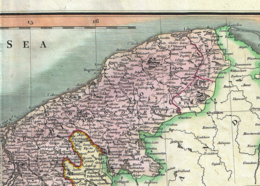
Back Hinterpommern Azerbaijani Bagpommern Danish Hinterpommern German Transpomerania Spanish Erdialdeko Pomerania Basque Taka-Pommeri Finnish Poméranie ultérieure French Pomerania Timur ID Pomerania Orientale Italian Hinnerpommern NDS
Farther Pomerania
Pomorze Tylne | |
|---|---|
| |
 Farther Pomerania in 1800 (in yellow) | |
| Country | |
| Historical region | Pomerania |
| Largest city | Koszalin |
| Time zone | UTC+1 (CET) |
| • Summer (DST) | UTC+2 (CEST) |
| Highways | |
Farther Pomerania, Hinder Pomerania, Rear Pomerania or Eastern Pomerania (Polish: Pomorze Tylne; German: Hinterpommern, Ostpommern), is a subregion of the historic region of Pomerania in north-western Poland, mostly within the West Pomeranian Voivodeship, while its easternmost parts are within the Pomeranian Voivodeship.
It is the part of Pomerania which comprised the eastern part of the Duchy and later Province of Pomerania. It stretched roughly from the Oder River in the West to Pomerelia in the East. The Polish term Pomorze Zachodnie ("Western Pomerania") is colloquially used in contemporary Poland as a synonym for the West Pomeranian Voivodship whose borders do not match the historical ones; in Polish historical usage, it applied to all areas west of Pomerelia (i.e. to the entire narrow Pomerania).

Farther Pomerania emerged as a subdivision of the Duchy of Pomerania in the partition of 1532, then known as Pomerania-Stettin (Szczecin) and already including the historical regions Principality of Cammin (Kamień), County of Naugard (Nowogard), Land of Słupsk-Sławno, and with ties to the Lębork and Bytów Land. After the Brandenburg-Swedish partition of Pomerania, Farther Pomerania became the Brandenburg-Prussian Province of Pomerania (1653–1815). After the reorganization of the Prussian Province of Pomerania in 1815, Farther Pomerania was administered as Regierungsbezirk Köslin (Koszalin). In 1938, northern part of the dissolved Grenzmark Posen-West Prussia was merged in.
After Germany's defeat in World War II, the region became again part of Poland. The German population was expelled in accordance with the Potsdam Agreement and replaced with Polish citizens, many of whom were expellees themselves as well.
Before 1999, the Szczecin Voivodeship (1945–1998) and its spin-offs Koszalin Voivodeship (1950–1998) and Słupsk Voivodeship (1975–1998) roughly resembled the area of former Farther Pomerania. The Szczecin and Koszalin Voivodeships were merged in 1999 and now constitute the West Pomeranian Voivodeship, while Słupsk Voivodeship was merged into the Pomeranian Voivodeship.
© MMXXIII Rich X Search. We shall prevail. All rights reserved. Rich X Search



